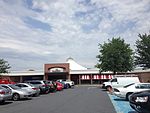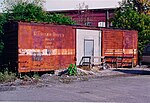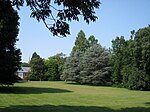Landis Mill Covered Bridge

The Landis Mill Covered Bridge is a covered bridge that spans the Little Conestoga Creek in Lancaster County, Pennsylvania, United States. A county-owned and maintained bridge, its official designation is the Little Conestoga #1 Bridge. The bridge, built in 1873 by Elias McMellen, is today surrounded by a development, shopping center, and highways on the boundary of Lancaster, Pennsylvania. At 53 feet (16 m), it is the shortest covered bridge in the county.The bridge has a single span, wooden, double pyramidal-shaped Burr-type trusses and multiple king post truss design with the addition of steel hanger rods. It is the only bridge in the county to use this design. The deck is made from oak planks. It is painted red, the traditional color of Lancaster County covered bridges, on both the inside and outside. Both portals to the bridge are painted in red with white trim. The bridge's WGCB Number is 38-36-16. In 1980 it was added to the National Register of Historic Places as structure number 80003526. It is located at 40°4′4.8″N 76°20′41.4″W (40.06800, -76.34483). It can be found northwest of Lancaster on Shreiner Road one block West of the Park City Center shopping mall.
Excerpt from the Wikipedia article Landis Mill Covered Bridge (License: CC BY-SA 3.0, Authors, Images).Landis Mill Covered Bridge
Shreiner Road, Manheim Township
Geographical coordinates (GPS) Address Nearby Places Show on map
Geographical coordinates (GPS)
| Latitude | Longitude |
|---|---|
| N 40.068 ° | E -76.3448 ° |
Address
Shreiner Road
Shreiner Road
17601 Manheim Township
Pennsylvania, United States
Open on Google Maps







